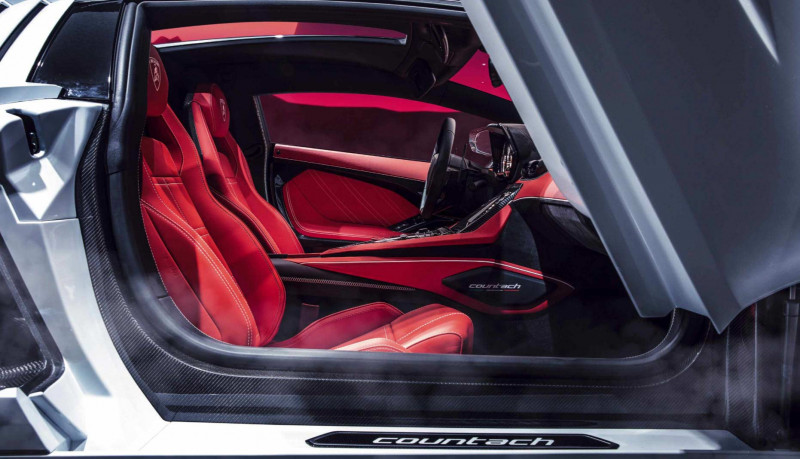Recreating an Eighties icon 2022 Lamborghini Countach LPI 800-4
Recreating an Eighties icon like the Countach? Good luck with that. And yet Lamborghini has taken a brave pill and dived right in
COUNTACH REBORN
Well you didn’t think Lamborghini was going to sit this one out, did you? The world’s most consistently flamboyant carmaker has gone back to the source… welcome to the Lamborghini Countach LPI 800-4. Imagine that the world’s greatest supercar had never ceased production, evolving instead through model cycles to rock up in 2021, 50 years after its shocking debut looking like… this. Only 112 will be made – referencing the original’s LP112 internal codename – costing north of £2m each. And they’ve all gone.

Anniversaries are easily won excitement generators and irresistible money spinners. Sant’Agata has been here before, of course. The Countach bowed out in 1989 with an actual Anniversary edition, although that car was celebrating the company’s 25 – mostly turbulent – years in the game (the car itself was a mere 18 at the time). Horacio Pagani was the man who dared to reframe the epochal original, an act akin to daubing a moustache and little round glasses on the Mona Lisa.
Less well remembered is 2006’s Miura concept, a 30th anniversary reimagining of the car that kick-started the whole mid-engined supercar thing in the first place. Walter de Silva did that one, but Lamborghini and its then-new boss Stephan Winkelmann evidently weren’t feeling it.

Half a century, though, is a substantial chunk of time. And both 1971 and the Lamborghini Countach are worthy of committed celebration. The Sixties changed everything, for good and bad, and it wasn’t until ’71 that the new decade announced that things were going to be different round here. The Stones gave us Sticky Fingers, Marvin Gaye his politically charged masterpiece What’s Going On, while David Bowie figured out who David Bowie was going to be on Hunky Dory (these are unquestionably three of the greatest albums ever made).
Meanwhile, in Turin a car designer called Marcello Gandini had spent much of the previous five years rehearsing his moves before setting the controls for the heart of the sun with ’71’s Lamborghini Countach LP500. If high performance Italian cars had previously dedicated themselves to a notably sensuous form language, things were definitely changing. You get the impression that Gandini would have made the wheels hexagonal if only that hadn’t defied 5,500 years of engineering evolution. Instead, he did the next best thing and ensured the wheelarches were acutely angled, along with the rest of the car. The trifling matter of being able to see out was dealt with by introducing a periscope – periscopio – in place of the rearview mirror. Not many cars used a periscope, and the channel it carved into the Countach’s roof would become a signature element. As did the infamous scissor doors, the only solution on a car as wide as this but another masterstroke. (See for our interview with the maestro.)

However, designing a car like this is one thing, building it quite another. And this is where Lamborghini stunned the world by actually putting Gandini’s UFO into production. “Earlier in the Sixties there was the Porsche 911 and the Jaguar E-type,” Lamborghini’s design director Mitja Borkert tells TopGear during a world exclusive preview of the new car in a secret viewing room. “We were coming out of the post-war aerodynamic design ethos and into something truly cutting edge. Especially in Italy. The big names were fermenting a design revolution but the Countach was the only one that became a reality. This is another thing that makes it so special.”
Borkert grew up in communist East Germany so was denied the full schoolboy poster-on-the-wall Countach experience. In fact, the first Gandini-designed car he remembers seeing was the Citroen BX. A cool thing in its own right, especially in a sea of Ladas, but no Countach. Five years into the job running Lamborghini’s Centro Stile, Borkert now knows every millimetre of every car the company has ever made. But none more than the Countach. “You can keep looking at it and never get tired,” he says. “The original was the culmination of that four-year period that resulted in the Alfa Romeo Carabo, the Bizzarrini Manta, Stratos Zero and Maserati Boomerang. We were going to the Moon, Concorde was in development, there were student uprisings in Paris and Prague. There was a lot of revolutionary thinking, and cars acquired a lot of hexagonal shapes and powerful graphics.”
Now Mitja and his team are risking the wrath of that corner of the internet that a) loves to reimagine hero cars and b) wastes no time abusing a carmaker if it goes there itself. This all-new 50th anniversary Countach is a risky enterprise and a reputation killer in the wrong hands. Fortunately, disaster has been averted. Weirdly, given its inspiration and the brand behind it, it’s a masterpiece of restraint, a homage that builds out on the original’s key elements without tipping into pastiche or, worse, appearing to be retro. Yes, once you know it’s a Sián underneath, you can see a bit too much of the donor from some angles, but look at the flat plan of the nose, the asymetric rear wheelarches, and the way the ducts behind the side windows keep faith with the ultra-controlled surfaces of the original. This is closer to the original than the later bewinged and more tumescent iterations, the ones that corrupted themselves for the coked up, big hair, metal loving Eighties. It’s taut, tight and looks terrific.

Its full name is Countach LPI 800-4, and its technical spec will be familiar to anyone acquainted with the recent Sián hypercar. In actual fact, this isn’t a new car but another run-out for the hard points that underpin the hugely successful Aventador and its derivatives. The engine is a 6.5-litre V12 that produces 774bhp, aided and abetted by a 48V e-motor that throws another 34bhp and 26lb ft into the mix. So the ‘I’ part of LPI stands for Ibrido, indicating Lamborghini’s first steps on a journey that will eventually culminate in full electrification. Needless to say, Lamborghini goes about things its own way: this hybrid uses a supercapacitor rather than a conventional lithium-ion battery. So while a supercap can’t store as much energy as a normal, equivalently sized battery, it has three times the power density and can also charge up pretty much instantly. Which makes it the best solution in the new Countach, where the motor’s power and the energy harvested under braking is used primarily to torque-fill during gearchanges. This is an area in which the Aventador’s fun but gnarly single clutch sequential box has never done its best work, shall we say, and we know from our experience in the Sián that the e-motor helps. It sits between the engine and gearbox, and weighs just 34kg. The chassis and body panels are made of carbon fibre, for enhanced structural integrity and lighter weight.
We doubt that anyone signing on the dotted line for a 50th anniversary Countach will be persuaded by its hybrid tech, though. This is all about bragging rights. But it also very deliberately reins in the showbiz. “The Countach went through a lot of versions during its life, although fewer than 2,000 were made, so the idea was to have a clean, solid and timeless design for this one,” recently returned CEO Stephan Winkelmann tells TopGear. “We wanted to highlight the best elements, the squared off wheelarches, the quad exhaust, the air intakes, and the amount of tyre that’s visible at the rear. We didn’t want to overload the car.
“This is a pure celebration of something that happened 50 years ago. As a rule I don’t like retro cars, I prefer to have a forward-looking vision. But the original didn’t just change Lamborghini’s DNA, it changed everything in the world of super sports cars, so this is a valid exercise. The Countach is always the reference car. It was the first of a kind.”
So it’s modernist rather than madcap. It’s also worth noting Mitja Borkert’s form in this regard: during his time at Porsche he authored the magnificent Mission E (the Taycan’s conceptual precursor) but was also responsible for the 917 Homage. This is a guy with an amazing knack for riffing off a company’s greatest hits without coming off like a tribute act. He concedes that renderings for a Countach 50 have been around for a while before the management finally gave it the green light. There may even have been pop-up headlights on one iteration.
“I couldn’t and wouldn’t go straight to this,” he confirms. “We created cars like the Terzo Millennio first. The Sián was a car for a concours event, where you take a glass of Prosecco and walk around the car and think, ‘do I like it? Do I not like it?’ It was intended to be a car with a lot of flavours inside, like a very complicated wine. The Sián is spectacular, it’s part of the continuum that gave us the Veneno and the other limited run cars. I know full well that some people don’t like it. That was part of the plan. But when it came to the Countach, I said to my guys, ‘Now I want the clean car that everyone is expecting from me.’”
The NACA duct has grown significantly, Mitja admitting that getting air into the engine was the biggest challenge of all. “Just as it was for Gandini,” he smiles. But while he admires the Quattrovalvole, the new car’s movable rear wing is preferable to an outsized fixed aero appendage. The drama of the original’s cut-off rear is repeated on the new car, including the quad exhaust pipes. The bianco siderale colour of the show car references Ferruccio Lamborghini’s personal Countach LP400 S but includes some metallic blue elements for more depth. Inside, the car gains an enlarged multimedia screen, 3D printed air vents, while the cabin is finished with a very Seventies square motif. There’s even a little button marked ‘Stile design’ which displays the design DNA of Lamborghini. Fortunately, there’s substantially more room inside than in the comically cramped original, though still nowhere to put your mobile phone. Speaking of which, the alloy wheels use the ‘telephone dial’ design motif. Overall, it’s a highly sophisticated piece of work, all the more so because it was completed as Italy’s COVID lockdown began and the team worked remotely.
“The Countach is the ultimate game changer,” Mitja concludes. “I recall seeing one during Pebble Beach on Highway 1 and you could identify it from a mile away. The Countach went out of production in 1990 but I always had the feeling there was unfinished business, that the perfect Countach was not there yet. “The NACA duct on the LP400 was a bit of an add-on. I love the QV because the wheels and wheelarches got wider. The Anniversary was a bit too much for me. So yeah, unfinished business. I wanted to do a car that was super clean and puristic. There’s just one line on the front wing and we wanted to play with big surfaces at the rear. I’m more than happy to play around with those different shapes on the different cars we have. The Essenza is a five and a half metre racing projectile. The Sián is a car beyond design. But the Countach is pure sculpture.”
These slotted rear intakes are faithful to the original 1971 show car Mitja Borkert with his homework. Don’t stress Mitja, you’ve passed with flying colours.
The Seventies can keep the flares, unless we’re talking about wheelarches.
While ergonomics on the original were comical, in here it’s positively spacious.
“THE WORLD’S MOST FLAMBOYANT CARMAKER HAS GONE BACK TO THE SOURCE”

